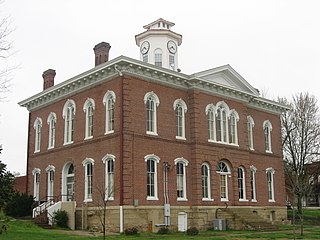
Williamson County is a county in Southern Illinois. At the 2020 census, it had a population of 67,153. The largest city and county seat is Marion.

Johnson County is a county in the U.S. state of Illinois. According to the 2020 census, it has a population of 13,308. Its county seat is Vienna. It is located in the southern portion of Illinois known locally as "Little Egypt".

Jackson County is a county located in the U.S. state of Illinois with a population of 52,974 at the 2020 census. Its county seat is Murphysboro, and its most populous city is Carbondale, home to the main campus of Southern Illinois University. The county was incorporated on January 10, 1816, and named for Andrew Jackson. The community of Brownsville served as the fledgling county's first seat.

Carbondale is a city in Jackson County, Illinois, United States, within the Southern Illinois region informally known as "Little Egypt". As of the 2020 census, the city had a population of 25,083, making it the most populous city in Southern Illinois outside the Metro East region of Greater St. Louis.

Christopher is a city in Franklin County, Illinois, United States. The population was 2,697 at the time of the 2020 census.

Omaha is a village in Gallatin County, Illinois, United States. The population was 209 at the 2020 census.

Ridgway is a village in Gallatin County, Illinois, United States. As of the 2020 census, the population was 851. As of 2021, Nancy Kitchens was the town mayor.

Dowell is a village in Jackson County, Illinois, United States. The population was estimated to be 385 at the 2020 census, down from 408 at the 2010 census.

Eldorado is a city in Saline County, Illinois, United States. The population was 4,122 at the 2010 census, with a 1980 peak of 5,198. Although the city's name is spelled as if it were Spanish, the name was originally "Eldereado" or “Elder-Reado” —a combination of the last names of the town's two founders, Judge Samuel Elder, his son William, grandson Francis Marion, and neighbor Joseph Read, and his brother William. According to legend, a signpainter for the railroad painted the name "Eldorado" on the train depot; as a result, the spelling and pronunciation (el-do-RAY-doh) was forever changed.

Carterville is a city in Williamson County, Illinois, United States. At the 2020 census, the city's population was 5,848. The city is part of the Carbondale-Marion-Herrin combined statistical area and has grown considerably as a residential community of Carbondale and Marion.

Crainville is a village in Williamson County, Illinois, United States. The population was 1,254 at the 2010 census.

Hurst is a city in Williamson County, Illinois, United States. The population was 795 at the 2010 census.

Johnston City is a city in Williamson County, Illinois, United States. The population was 3,348 at the 2020 census. This was a center of coal mining in the early 20th century, having a peak of population in the 1920s. The mining jobs attracted many immigrants from Europe.

The city of Marion is the county seat of Williamson County, Illinois, United States. The population in the Marion city, IL was 16,867 per American Community Survey data for 2018-2022.

Spillertown is a village in Williamson County, Illinois, United States. The population was 203 at the 2010 census and as of 2018, the population has grown to an estimated 272.
Whiteash is a Census designated place in Williamson County, Illinois, United States. The population was 268 at the 2000 census, and dropped to 248 in the 2010 census. This village dissolved in 2014.

Bussey is a city in southeast Marion County, Iowa, United States. The population was 387 at the time of the 2020 census.

Carbondale is a city in Lackawanna County, Pennsylvania, United States. Carbondale is located approximately 15 miles due northeast of the city of Scranton in Northeastern Pennsylvania. The population was 8,828 at the 2020 census.

Metro Lakeland is a name that was coined in the 1960s for an area of southern Illinois that is centered on the intersections of Interstate 57, Interstate 24, and Illinois Route 13 — a four-lane east-west highway connecting the communities of Murphysboro, Carbondale, Carterville, Herrin, Marion, and Harrisburg. Metro Lakeland was defined as Jackson, Williamson, Franklin, Saline, and Perry counties, with a combined population of approximately 210,000. Carbondale, Herrin, and Marion are the key urban areas, with a combined city-proper population of over 65,000 Carbondale, the site of Southern Illinois University, is the region's largest city. Metro Lakeland is about 88 miles (142 km) southeast of St. Louis, Missouri, or 120 miles (190 km) by Interstate highway.
Halfway, Illinois was a rough and very wet unincorporated community nicknamed "Little Juarez" in Williamson County, Illinois, at what is believed to the crossroads of Illinois Route 37 and Prosperity Road between Marion and Johnston City. Its heyday was between 1915 and 1925. The name originated because it was about halfway between Marion and Herrin, located a few miles to the west on what is now a county highway. The nickname came about from the general lawlessness, shootings and proliferation of gambling and booze, even during Prohibition.






















